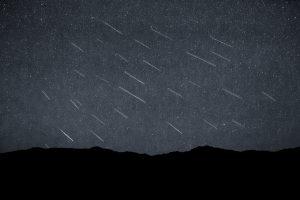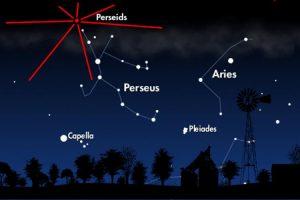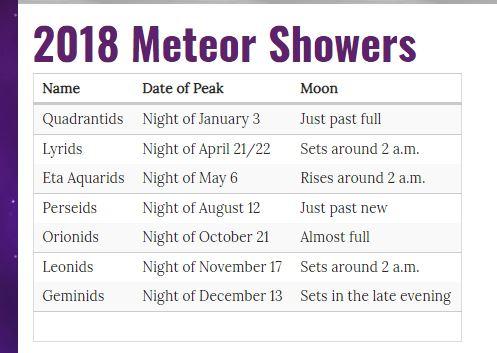Posted by Beth on Thursday, Aug 9, 2018
The Perseid meteor shower occurs each year in late Summer, with peak viewing around the 2nd
 week of August. In 2018, the peak will be this weekend, August 10-12, when more than 50 meteors per hour should be visible in the night sky. The meteors will be the heaviest in the hours between midnight and dawn, and this year the August 11th new moon will set early in the evening, so it won't interfere with viewing.
week of August. In 2018, the peak will be this weekend, August 10-12, when more than 50 meteors per hour should be visible in the night sky. The meteors will be the heaviest in the hours between midnight and dawn, and this year the August 11th new moon will set early in the evening, so it won't interfere with viewing.
The Perseid meteor shower happens when the Earth passes through the orbital path of the Swift-Tuttle comet. Swift-Tuttle orbits the sun every 133 years, and each time it gets close to the Sun, small pieces break off and join the cloud of debris in the comet's orbit. When Earth passes through the Swift-Tuttle's debris field, some of the debris bounces off the Earth's atmosphere creating the Perseid meteor shower.
 The Perseids appear to originate from the top of the constellation Perseus. During August, Perseus will be found in the Northeastern Part of the sky, to the left of the big Dipper. The point in space where a meteor shower seems to originate from is called it's "radiant." All the meteors will appear to fly outwards from that point in the sky.
The Perseids appear to originate from the top of the constellation Perseus. During August, Perseus will be found in the Northeastern Part of the sky, to the left of the big Dipper. The point in space where a meteor shower seems to originate from is called it's "radiant." All the meteors will appear to fly outwards from that point in the sky.
There are many great Astronomy websites with information about the Perseids. Sky & Telescope is a website and print magazine for astronomy fans of all levels. They cover all kinds of news and events as well as review equipment, books and software. Their "resources and education" section can keep you busy for hours. My current favorite is the Astophotography: Tips & Techniques section.
 The University of Texas at Austin's McDonald Observatory's web site "StarDate" has lots of information for people new to star gazing and astronomy. Clicking on the "Stargazing" tab on their homepage will give you a list of things visible in the night sky this week. This is also where you'll find a link to the Meteor Shower Page. And they also have this great table of regular meteor showers throughout the year if you miss the Perseids.
The University of Texas at Austin's McDonald Observatory's web site "StarDate" has lots of information for people new to star gazing and astronomy. Clicking on the "Stargazing" tab on their homepage will give you a list of things visible in the night sky this week. This is also where you'll find a link to the Meteor Shower Page. And they also have this great table of regular meteor showers throughout the year if you miss the Perseids.
The Earth Sky is a great science website for non-scientists. Their Top 10 Tips For Watching The Perseids is a must read - and includes things like information about the Perseids is easy to read and has lots of information about the origins of the Perseids as well as how and when to find them and general tips on viewing.
To learn more about Comets, Meteors and Meteor Showers, the NASA website is a great place to start. You'll find information about planets, asteroids, and comets as well.
The Iowa City Public Library has lots of material about Astronomy and Stargazing. The staff at any of the public service desks can help you find more information.


This book would be great for anyone -from those who are curious about quilting to longtime quilters. StashBooks has combined chapters by 20 well known artists from the who's who of the quilting world to come up with a great book about quilting. Quilt artists like Alex Anderson (alexandersonquilts.com), Angela Walters (quiltingismytherapy.com and The Midnight Quilt Show), Carrie and Harriet Hargrave (quiltersacademy.com) walk you through quilting -starting with what supplies you'll need through a variety different types of quilting - from applique to paper piecing. A really great book for anyone who is or wants to be a quilter. -Beth